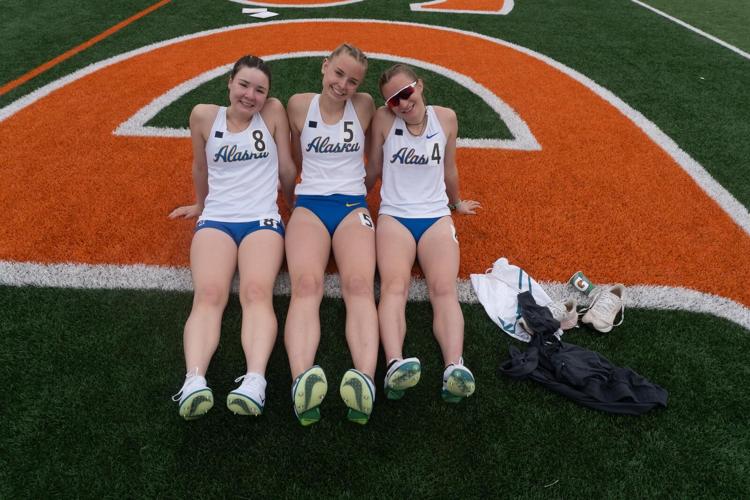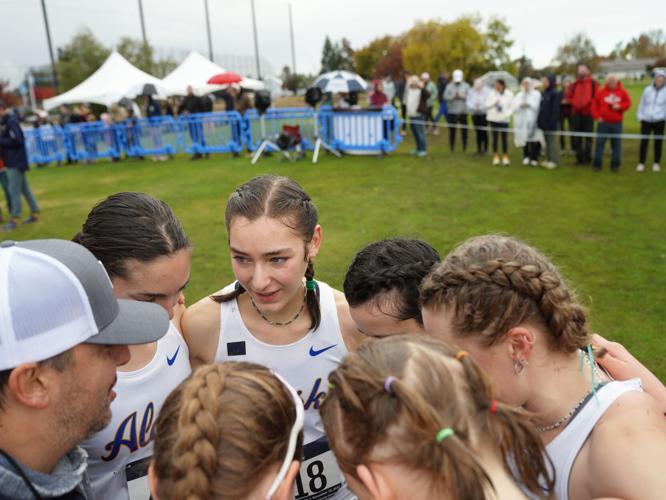Last spring, members of the University of Alaska Fairbanks cross country team took a multi-weekend trip to the East Coast to compete in a couple of track and field meets. This month, they spent a few weeks in California. It’s all part of an effort to potentially bring track and field to a university that doesn’t sponsor any spring sports.
UAF’s athletics year is usually over by mid-March, once hockey, skiing and rifle wrap up. However, 18 different Nanooks (three times as many as last year) competed in a series of track meets throughout the month of April, culminating this past weekend.
The trips have been organized by UAF assistant coach Conrad Haber, who runs the day-to-day operations of the Nanooks’ cross country teams. Haber is in his second year at UAF and helped the Nanooks to their best finish in program history in November.
“That was like the first thing I recognized is that when cross country ended, everyone kind of went their own way,” Haber said Monday. “And I was just ‘[forget] that.’ There’s no way we can build a program if we’re just going to do whatever we want for six months. Everyone else is getting that opportunity to work on weaknesses, do things that are a little bit faster, and continue to learn how to race and continue to build via training.”
Thus, an idea was conjured to keep athletes engaged outside of their competition season and give them an opportunity to run fast over shorter distances on an even surface (rather than on the grass during cross country). Haber was previously the head coach for a nationally competitive high school track and field team, and he calls middle distances like the 800 meters and 1500 meters his “bread and butter.”
The 800 meters (or half mile) ended up being one of the events in which the Nanooks experienced the most success this spring.
In that event, UAF senior Finn Morley ran one minute and 56 seconds (1:56) to finish third of 22 men in his heat at the 2025 Leopard Invite hosted by La Verne University this past weekend.
On March 29, UAF junior Teegan Silva ran 2:15 for 800 meters to win her heat at the 2025 Pacific Open by almost five seconds over runner-up Lucia Garcia of Alaska Anchorage. She also ran 2:16 at the Pomona-Pitzer Invitational on April 12, as did Rosie Fordham, a multi-time cross country All-American who’s in her final year at UAF.
Both of those women also ran quick 1500-meter marks. Riga Grubis, who transferred to UAF after originally competing for Willamette University as a triathlete, ran 2:18 for 800 meters. Olivia Manley, a UAA-to-UAF transfer who was previously a sprinter, ran 2:20.
“It’s not like we were out recruiting middle distance runners,” Haber said. “It’s an event I like to coach, and we were able to think creatively about it. But I was really impressed with that.”
Freshman Benjamin Browning (15:02 or 4:50 per mile) and senior Koen Ross (15:37) comfortably dipped under the 16-minute barrier for 5000 meters. Browning also ran 31:13 to place sixth of 24 men in a 10k race at the Leopard Invite.
Lucca Duke placed sixth of 72 women, ahead of dozens of Division I athletes, in her section of the 5000 meters at the Bryan Clay Invitational last week. She ran 17:23. Curtis Beck, a current UAF freshman who won the 2024 ASAA Division I 400-meter title for West Valley, ran 49.72 seconds in that event this month to get close to his personal best, and he dipped under 22 seconds in the 200 meters for the first time at the Pacific Open.
The Nanooks also put together men’s and women’s 4x400-meter relay teams and even had a freshman, Kintla Penn, competing in the 100-meter hurdles and 400-meter hurdles.
When they weren’t competing during their time in California, the Nanooks went to Santa Monica and Hermosa Beach — where they were “drawn to the sun like moths to a flame” — ran in canyons and went to a Los Angeles Dodgers game.
“I think it helps the team to come together when you’re spending that time together as a group, going on little excursions,” Haber said.
Training for track and field in the winter and spring in Fairbanks is difficult, which is part of why UAF doesn’t have an indoor or outdoor track and field team. UAF doesn’t have an outdoor track or an indoor track facility, and snow, ice and frigid temperatures make training outside unpredictable and suboptimal.
A handful of winter meets at The Dome in Anchorage were critical to conditioning and preparing the Nanooks for their competitions in California as well as having times to enter into other meets.
The Nanooks competed unattached in those meets at The Dome because they weren’t within the 45-day window in which athletes were able to represent UAF without the university having an official team.
They completed their track workouts on the indoor track on the second floor of UAF’s Student Recreation Center (SRC). The key, however, wasn’t high mileage.
“The biggest thing that we do is we don’t run that much, it’s a lot of cross training,” Haber said
“ ... We’re not trying to force a square peg into a round hole. So instead of having athletes try to do every run on treadmills, they’re skiing, they’re swimming or fat tire biking, they’re [on the] elliptical. You’re pulling every tool possible to get what we need so that we’re not constantly running on the SRC track. But we do have our workout days. We’re never really able to work out outside. It was always too hard to run fast in the snow.”
Haber hopes that what began as a way to continue training and to stay in shape through the offseason not only benefits the ‘Nooks next fall but provides a step toward UAF starting a track program.
“To me what ultimately was probably the biggest thing is that we looked like a team that had been practicing on the track just like everyone else had since November,” Haber said. “You would not have guessed that we don’t have access to any of that stuff.”





